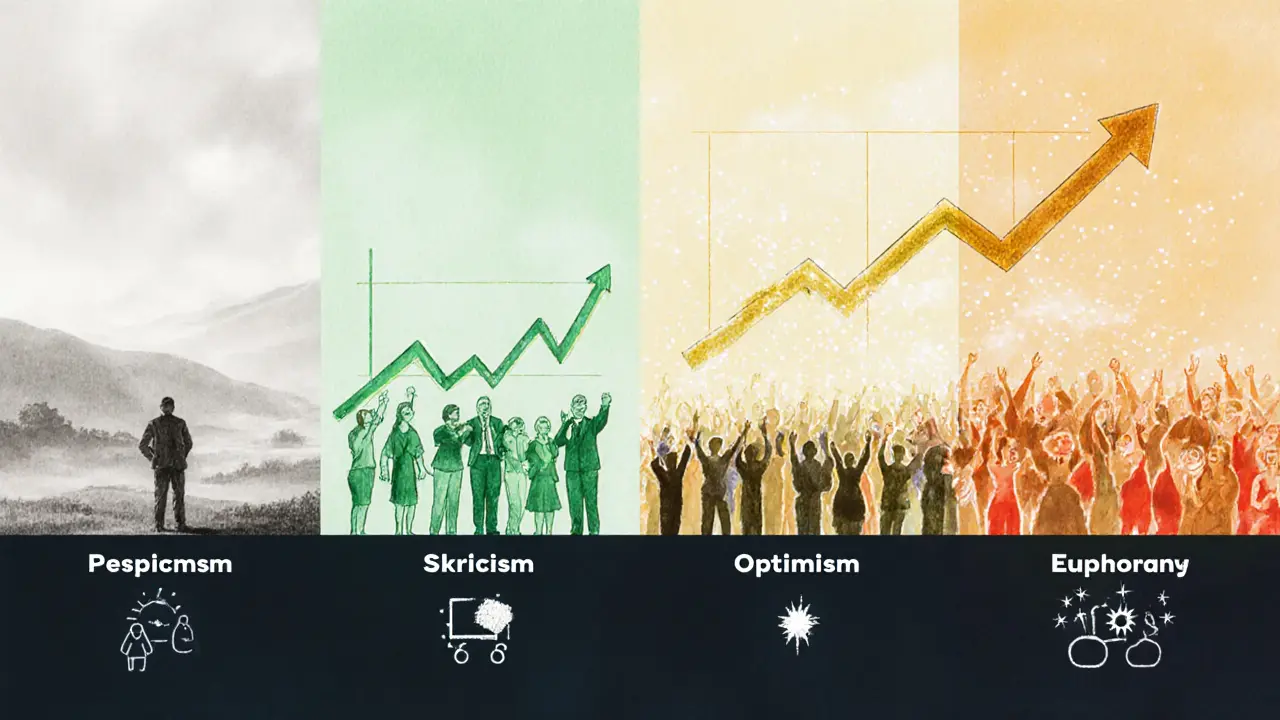Bull vs Bear Market Psychology: Why Emotions Drive Stocks

Bull vs Bear Market Psychology Explorer
Bull Market
A sustained rise of at least 20% from a recent low, driven by optimism and growth expectations.
Bear Market
A decline of 20% or more from a recent high, fueled by fear and loss aversion.
Bull Market Sentiment Stages
Key Psychological Biases
Bull Market Traits
- Dominant Emotion: Optimism → Euphoria
- Typical Bias: Overconfidence, Greed, FOMO
- Common Behavior: Buy-and-hold, leverage, sector concentration
- Focus: Growth, upside potential
Bear Market Traits
- Dominant Emotion: Fear → Panic
- Typical Bias: Loss aversion, Herd panic
- Common Behavior: Sell-off, flight to defensive assets, cash hoarding
- Focus: Capital preservation, risk reduction
Emotional Impact on Decision Making
Bull Market: Greed and FOMO push investors to buy at peak prices, often ignoring fundamentals.
Bear Market: Fear and loss aversion cause investors to sell early or hold onto losing positions too long.
Defensive Strategies
Bull Markets: Diversify investments, set stop-losses, limit speculative plays.
Bear Markets: Shift to defensive stocks, maintain cash reserves, consider bonds.
When markets swing up or down, it’s rarely just numbers doing the heavy lifting. Human feelings-optimism, fear, greed, envy-steer buying and selling far more than earnings reports. Understanding the psychology of bull and bear markets is the secret sauce that separates a calm investor from a panicked trader.
Quick Takeaways
- Bull markets are born on pessimism, grow on skepticism, mature on optimism, and die in euphoria.
- Bear markets thrive on fear, loss‑aversion, and a rush to defensive assets.
- Key biases-herd mentality, overconfidence, loss aversion, and FOMO-show up in both cycles.
- Recognizing the emotional stage can help you avoid costly timing mistakes.
- Simple habits like setting stop‑losses and diversifying reduce the impact of emotional swings.
What Exactly Is a Bull or Bear Market?
A Bull Market is defined as a sustained rise of at least 20% from a recent low. Prices climb, headlines glow, and investors start feeling the confidence that the rally will keep going. In contrast, a Bear Market drops 20% or more from a recent high, brings headlines of doom, and triggers a wave of selling.
These thresholds are technical, but the emotional under‑currents are what really drive the moves.
The Emotional Journey of a Bull Market
Behavioral researchers like Davis Funds break a bull market into four sentiment stages:
- Pessimism - Investors doubt the rally can start.
- Skepticism - A few early winners prove the trend is real, but most remain cautious.
- Optimism - More participants join, believing the market is trending upward.
- Euphoria - Greed and FOMO (fear of missing out) dominate, pushing prices to overvalued levels.
Each stage fuels the next, creating a self‑reinforcing loop where rising prices attract more buyers, and the cycle eventually bursts when optimism flips to panic.
Key Psychological Forces in Bull Markets
Overconfidence bias spikes as investors remember recent wins and start believing they can "beat the market" with short‑term trades. Day traders especially fall prey, assuming their timing skill is superior.
Greed and envy emerge when some participants secure massive gains. The desire to chase those returns pushes many to over‑leverage or pile into hot sectors without checking fundamentals.
Herd mentality turns individual analysis into copy‑cat behavior. When news outlets hype a rally, the crowd assumes the majority must be right, and dissenting voices are ignored.
All these forces combine to inflate valuations well beyond what earnings alone would justify.

Bear Market Mindset: Fear Takes the Wheel
When the tide reverses, loss aversion becomes the dominant driver. Investors feel the pain of a loss far more intensely than the pleasure of an equivalent gain, prompting them to sell winners early and hold losers too long.
The market’s negative sentiment fuels a feedback loop: falling prices increase fear, prompting more selling, which drives prices even lower. This spirals until a new floor of confidence forms, often in defensive sectors.
During a bear phase, many shift to defensive stocks-utilities, consumer staples, and health‑care-because they’re perceived as less risky when the economy sputters.
Core Cognitive Biases Across Both Cycles
Besides the stage‑specific biases, several universal mental shortcuts shape decisions:
- Anchoring: Investors cling to price points from a previous market (e.g., “I bought at $50, so I won’t sell below $55”), even when new data suggests a different valuation.
- Herd mentality: The urge to follow the crowd, evident in both panic selling and euphoric buying.
- Overconfidence: Inflated belief in one’s forecasting ability, especially after a string of wins.
- Loss aversion: Prioritizing avoidance of loss over achieving gains.
- FOMO: Jumping in at market peaks out of fear of being left out.
Recognizing these biases helps you spot when emotions-not fundamentals-are driving the price.
Defensive Strategies for Bear Markets
When fear dominates, investors typically re‑balance toward safer assets:
- Sector rotation: Moving capital from cyclical stocks (e.g., tech, discretionary) into defensive ones (e.g., utilities, consumer staples).
- Cash allocation: Holding a larger cash buffer reduces anxiety and provides buying power when the market bottom appears.
- Bond exposure: High‑quality government or investment‑grade corporate bonds tend to hold value when equities tumble.
- Diversified ETFs: Broad‑market funds can smooth out volatility compared to single‑stock bets.
These moves aren’t about beating the market; they’re about managing the emotional roller‑coaster.
Psychology at a Glance: Bull vs Bear
| Attribute | Bull Market | Bear Market |
|---|---|---|
| Dominant emotion | Optimism → Euphoria | Fear → Panic |
| Typical bias | Overconfidence, Greed, FOMO | Loss aversion, Herd panic |
| Common behavior | Buy‑and‑hold, leverage, sector concentration | Sell‑off, flight to defensive assets, cash hoarding |
| Investor focus | Growth, upside potential | Capital preservation, risk reduction |
| Market signal interpretation | Positive news reinforces buying | Negative news accelerates selling |
Practical Tips to Keep Emotions in Check
- Set clear rules: Define entry, exit, and stop‑loss levels before you trade. Stick to them even when headlines scream “buy now”.
- Use a diversified portfolio: Spreading risk across sectors and asset classes softens the blow of any single sentiment swing.
- Limit exposure to hot trends: Allocate only a small slice (e.g., 10‑15%) to speculative plays that could explode in a bull or evaporate in a bear.
- Review decisions weekly: Write down why you entered a position. If the reason was “I felt the market was crazy”, it’s a bias flag.
- Take regular breaks: Stepping away from screens reduces the urge to act on every price tick.
By turning emotional awareness into a habit, you’ll avoid the classic mistake of “buying high, selling low”.

Frequently Asked Questions
What triggers a bull market beyond good earnings?
Psychology plays a bigger role than numbers. When investors collectively feel optimism, they start buying out of fear of missing the upside, which pulls prices higher regardless of short‑term earnings. Media hype, low‑interest rates, and even the success stories of a few high‑flyers can ignite that optimism wave.
Can I profit in a bear market without short‑selling?
Yes. By shifting to defensive stocks, high‑quality bonds, or cash, you preserve capital while others panic‑sell. When the market eventually bottoms, you have buying power ready to capture the rebound.
How does herd mentality differ from logical crowd behavior?
Logical crowd behavior occurs when many investors independently arrive at the same conclusion based on solid data. Herd mentality, however, is a blind follow‑the‑majority reaction where the underlying analysis is ignored, often leading to overreactions on both sides of the market.
Is loss aversion always a bad thing?
Not necessarily. It can keep you from taking reckless leverage. The downside is staying stuck in losing positions too long. Balance it by setting predefined stop‑losses that force you out before emotions take over.
What role does technical analysis play in understanding market psychology?
Technical charts capture the collective actions of market participants. Patterns like higher highs or lower lows often reflect the prevailing emotional tone-whether optimism or fear is driving price moves. Combine chart signals with a bias checklist for a fuller picture.







When you overlay the classic risk‑adjusted return curve with the underlying market sentiment, the beta exposure tells a story that's more about psychology than fundamentals. The transition from optimism to euphoria is essentially a feedback loop that inflates the Sharpe ratio artificially. In a bull phase, the volatility compression often masks the latent systemic risk, which can explode once the macro narrative flips. Conversely, during a bear dribble, the downside skew becomes dominant, pulling the implied volatility surface upward. Keeping an eye on those sentiment‑driven alpha sources can help you stay ahead of the herd.
The market, in its relentless march, mirrors the human condition, oscillating between hope and dread with a rhythm that feels almost predestined. Each surge of optimism is a collective affirmation that we have mastered the forces of scarcity, yet the underlying fragility remains hidden beneath layers of speculative fervor. When investors cling to the narrative of perpetual growth, they construct a cognitive bias loop that inflates valuations beyond any reasonable expectation of earnings. This loop is sustained by the dopamine hit of rising prices, which temporarily suppresses the brain's loss‑aversion circuitry. Conversely, the onset of fear triggers a hyper‑vigilant state where the same circuitry amplifies the perception of risk, forcing a rapid exodus from equities. The transition between these states is rarely smooth; it is punctuated by abrupt sentiment shocks that can be traced to macro policy cues or unexpected earnings headlines. Behavioral economists label this as the ‘availability heuristic’, where recent vivid events dominate decision‑making far more than abstract data. In practice, traders who ignore these psychological undercurrents often find themselves on the wrong side of the trade, buying at peaks and selling at troughs. A disciplined approach therefore requires a meta‑analysis of sentiment indicators alongside traditional fundamentals. Tools such as the VIX, market breadth, and even social media sentiment can act as early warning systems for a shift in collective mood. However, these signals are not infallible; they merely highlight probabilities that must be weighed against personal risk tolerance. The wise investor cultivates a habit of stepping back, reviewing the rationale behind each position, and asking whether the current bias aligns with objective reality. By doing so, one reduces the emotional weight of each trade and preserves capital for the next cycle. Ultimately, markets are a mirror reflecting our own psychological makeup, and recognizing that mirror is the first step toward mastering the game. So, the next time you feel the rush of euphoria or the chill of dread, remember that you are experiencing the same forces that have moved markets for centuries.
Understanding the stages you outlined gives investors a useful roadmap for self‑assessment. If you notice yourself moving from optimism straight to euphoria, it’s a cue to tighten risk controls. Likewise, spotting early fear can signal an opportunity to re‑balance toward defensive assets. Keeping a journal of these emotional shifts can make future decisions more data‑driven.
Bull markets just make the same old noise louder.
It is incumbent upon the disciplined investor to recognize that unchecked greed erodes the very foundations of market integrity. When participants chase returns without regard for underlying value, they sow the seeds of systemic fragility. Ethical stewardship requires establishing clear entry and exit criteria grounded in fundamental analysis rather than fleeting hype. Moreover, a commitment to transparency and humility can temper the excesses that precipitate sudden corrections. By adhering to these principles, the community safeguards both personal wealth and collective market health.
The moment you start justifying over‑leverage because “the market’s on fire” you’re courting disaster. Greed masquerades as confidence, but it’s a thin veneer that shatters the instant volatility spikes. Pull the plug on any position that feels like a lottery ticket and replace it with a strategy anchored in risk‑adjusted returns. Stop treating market euphoria as a personal invitation; it’s a collective trap. Rein in that impulse before it empties your account.
Don’t let the market’s mood dictate your confidence-build a system that works even when sentiment drifts. A solid stop‑loss and diversified exposure keep you in the game during both bull runs and bear retreats. Stay hungry for knowledge, and let each swing teach you something new. The next rally will reward those who kept a level head.
Think of your portfolio as a living organism; you need to feed it with balanced nutrients, not just the high‑sugar spikes of hype. Allocate a core allocation for steady growth, a tactical slice for opportunistic plays, and a defensive buffer for downside protection. Monitoring beta, alpha, and the Sharpe ratio helps you gauge whether you’re over‑exposed to market euphoria. When the sentiment gauge tips toward panic, reinforce your defensive layer rather than chasing the falling knife.
Every market cycle is a workout for your discipline muscles-push through the easy gains and brace for the tough reps. Use the fear gauge as a timer to remind you when to tighten stops, and the greed gauge to signal when you might be overreaching. Mix in some cash reserves so you’re ready to sprint when the next bull opens up. Keep the momentum, but stay grounded.
When I first dove into the world of market psychology, I was struck by how often the same story repeats itself, like a favorite song on repeat, each verse echoing familiar themes of optimism, hubris, dread, and redemption. The bull’s joyous march from pessimism to euphoria feels almost cinematic, with investors casting themselves as heroes riding a wave of inevitable prosperity, only to discover that the wave can capsize at any moment. Conversely, the bear’s cold, relentless descent paints a stark picture of caution, where every dip feels like a personal loss, yet it also offers a quiet laboratory for the patient observer to refine his craft. What truly fascinates me is the way our brains, wired for survival, latch onto these emotional cues, turning price charts into a proxy for collective human sentiment. By learning to spot the subtle shift from “just a little bit of fear” to full‑blown panic, you can position yourself not just to survive, but to thrive. The key, of course, lies in marrying that psychological insight with hard‑nosed fundamentals, lest you fall prey to the siren song of pure speculation. So next time you see a headline screaming “record highs” or “market crash imminent,” remember it’s the same human story playing out on a larger stage. Embrace the rhythm, respect the cycles, and let the psychology be your compass rather than your master. In the end, the market rewards those who understand the narrative they are part of, not those who merely watch it from the sidelines.
It would be a disservice to the prudently minded to accept the prevailing bullish consensus without rigorous interrogation. While many herald the current ascent as a testament to underlying economic vigor, a closer examination reveals overvaluation, compressed yields, and speculative excesses that belie such optimism. One must therefore entertain the possibility that a corrective phase may be imminent, irrespective of the jubilant narratives circulating in popular media. To align oneself with the minority viewpoint is not an act of contrarian bravado, but a disciplined adherence to objective analysis over herd sentiment.
Yo, if you’re feeling the heat in a bear, just remember it’s a perfect time to snag some solid dividend players. Keep it chill, stick to your plan, and don’t let the noise mess with your head.
Everyone’s shouting “buy now”, but I think the market’s already too hot for that.
Interesting take! 🤔 While the optimism feels loud, I see the same warning signs you mentioned-over‑extension, thin liquidity, and the classic “everyone’s right” bias. 📉 Keeping a modest exposure could be wise.
In the grand theater of finance, each price movement is but a stanza in an endless poem of human desire and fear. When the bull roars, it is the echo of collective ambition; when the bear growls, it is the chorus of self‑preservation. Recognizing that these forces are reflections of our inner narratives grants us the power to write our own verses, rather than merely recite the market’s script. Thus, by mastering the psychology, we become the authors of our financial destiny.